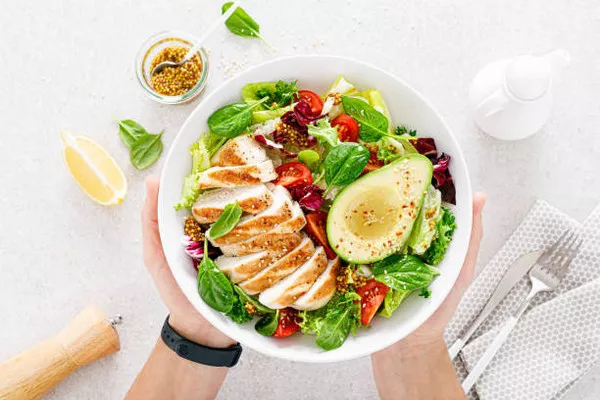Protein Diet
Sustaining and adding to our muscle mass through exercise and diet can benefit our balance, mobility, and even our ability to fight off disease as we age.
Ever feel like you’re wasting away? You might be right, as it could be related to age. Around the age of 50, our muscles start losing mass—about one or two percent a year, according to some estimates. This rate increases to three percent after age 60. “It’s a normal part of the aging process. We’re all going to lose muscle,” says Dr. Carla Prado, director of the Human Nutrition Research Unit and associate professor at the University of Alberta. “But there’s a threshold where you lose too much, and that becomes a big problem.”
Sarcopenia, the medical term for age-related muscle loss, can affect balance and walking. It also increases the risk of falling as our strength decreases. Muscle tissue serves as a holding tank for amino acids, which are crucial for various body functions, including immune system regulation and tissue repair. Nine amino acids, known as “essential” amino acids, cannot be produced by our bodies, so we must obtain them through our diet. Unfortunately, emerging research suggests that dietary guidelines have underestimated the amount of protein we need. This gap is even more significant for older adults or those with chronic diseases because our ability to process protein decreases. If muscle mass is shrinking, so is our ability to fight off disease and recover from injuries.
Fortunately, you can take steps at any age to preserve or even build muscle mass, which could extend your life. A 2018 study at the University of Michigan showed that among more than 8,000 seniors aged 65 and over, those with greater muscle mass outlived their weaker peers.
While building muscle involves weight-training and weight-bearing exercises, diet plays a key role. “We need nutrition to fuel our muscles,” says Prado. “You can exercise, but if you’re not getting enough nutrition, where will the energy and nutrients come from to build muscle?” Depending on age and health, you should aim for 1 to 1.5 grams of protein per kilogram of body weight—higher than the 0.8 grams recommended by Health Canada, which hasn’t been updated since 2005. For example, a senior with a health issue weighing 59 kilograms (130 pounds) might need up to 88 grams of protein daily.
Here are seven power foods that can improve your muscles and your odds for a longer, stronger life:
1. Edamame
The Bonus: A source of dietary fiber
Vegetarians can still get all essential amino acids by including varied plant-based proteins. Edamame and soybean products like tofu are exceptions. Edamame is particularly high in leucine, an amino acid that acts as an “on” switch for muscle growth. Additionally, edamame provides dietary fiber, which helps prevent bloating—a common issue that can interfere with workouts.
2. Chicken Breast
The Bonus: An amino acid powerhouse
Chicken breast is rich in protein (one breast contains 31 grams) and is a complete protein source, meaning it contains all nine essential amino acids. “Meat should not be avoided as long as it’s lean,” says Prado. Eat red meat in moderation and avoid processed meats, which are high in saturated fats and sodium.
3. Plain Greek Yogurt
The Bonus: A vitamin D and calcium fix
Greek yogurt is more concentrated than regular yogurt, offering 11 grams of protein per half-cup serving. It also provides calcium and is often fortified with vitamin D, which are essential for muscle health. However, some strains may lower the calcium content, so check labels to ensure you’re getting enough protein and calcium.
4. Salmon
The Bonus: A chronic inflammation fighter
Salmon offers 24 grams of protein per 100 grams and contains omega-3 fatty acids. These help control chronic inflammation, which can accelerate muscle loss, and improve insulin sensitivity, potentially aiding in muscle mass development. Omega-3s have also been shown to help cancer patients preserve muscle mass during treatment.
5. Walnuts
The Bonus: The nut that packs the most punch
Walnuts stand out among nuts for their high omega-3 content and provide three grams of protein per 10 halves. Nuts like almonds, pistachios, and cashews also offer protein but typically in smaller amounts compared to walnuts.
6. Eggs
The Bonus: Loaded with omega-3s
Eggs are a complete protein source and easy to digest. They can also provide omega-3 fats. Eating whole eggs rather than just the whites is recommended, as a 2017 study found a greater muscle response from whole eggs post-workout compared to egg whites alone.
7. Whey Protein
The Bonus: The best way to supplement
While whole foods should be the primary source of protein, whey protein can be a useful supplement if your diet is lacking. A study from McMaster University found that older women experienced more muscle gain with whey protein supplementation. This powder can be added to various foods, making it a versatile option for boosting protein intake.
It’s More Than What You Eat
Physical activity is also crucial for maintaining health, especially as we age. “Exercise is important,” says Dawn Bowdish, an immunity and infectious disease expert at McMaster University. Incorporate physical activity into your daily routine, even if it’s just light exercises at home or chores. Activities like gardening or house cleaning also contribute to maintaining muscle mass and overall health.


